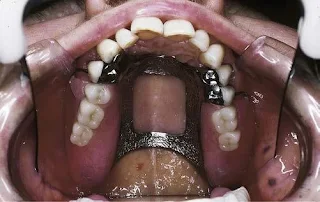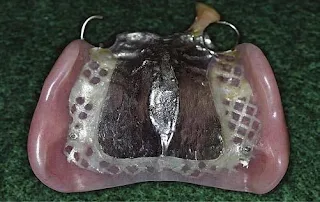Major connectors are the part of the removable partial denture which connects the components on one side of the arch to the components on the other
What are Major Connectors?
Major connectors are the part of the removable partial denture which connects the components on one side of the arch to the components on the other side of the arch. Moreover, it is a unit of the removable partial denture to which all other parts are directly or indirectly attached.
Ideal requirements of maxillary and mandibular major connectors
- The major connectors must be rigid. It should not be flexible. Rigidity will help in the uniform distribution of the forces acting on any portion of the prosthesis without undergoing distortion.
- It should protect the soft tissues and provide vertical support.
- It should provide indirect retention whenever required.
- It should not allow any food accumulation and must be comfortable for the patient. It should be self-cleansing.
Design of maxillary and mandibular major connectors
The border of the major connector should be 6mm away from the gingival margins in the maxillary arch to avoid any injury to the highly vascular marginal gingiva. In the mandible, major connectors should be placed 3mm away from the marginal gingiva. If it is not possible, it should be extended across the marginal gingiva as a lingual plate.
The borders of the major connectors should be parallel to the gingival margins and it should be rounded The metal framework should cross the gingival margin only at right angles. The anterior border of the maxillary major connector should end in the valley of the rugae and it should never lie on the crest of the rugae. It is better to avoid covering the rugae area to prevent discomfort during speech. The major connector should not extend over bony prominences like tori. Relief is given for small tori, surgical excision is done for a large one.
Classification of Major Connectors
Maxillary Major Connectors
- Single Palatal bar
- Single Palatal strap
- Antero-posterior palatal bar/ Double bar
- Horseshoe or U-shaped connector
- Antero-posterior palatal strap or closed horseshoe
- Complete palate
Single palatal bar
Palatal connector having less than 8mm in width. It is the least logical of all palatal connectors. It has to be made bulky, to maintain rigidity. It derives the least support from the palate.
Indications
It is used in place of interim partial dentures.
Disadvantages
It cannot be used anterior to the premolar region, due to interference to the tongue. It is used only in the Kennedy Class III situation.
Single Palatal strap
It should be at least 8mm wide for adequate rigidity. It is not bulk as compared to Palatal bar. Its width can be increased, as the edentulous span increases in length
Indications
Best suited for short span edentulous spaces in tooth-supported prosthesis i.e, Kennedy's Class III Cases.
Disadvantages
It causes papillary hyperplasia. The posterior border should end before the junction of the hard and soft palate.
Antero-posterior palatal bar (Double palatal bar)
It is the combination of anterior palatal central and posterior palatal bar. It is the most rigid palatal major connector. The anterior strap is narrower than the conventional palatal strap. The posterior bar is half oval and has a width equal to the single palatal bar and is less bulky. It is strong, rigid and limited soft tissue coverage.
Indications
It is used in a long edentulous span in class II modification I arch. It is also used in presence of tori, which is not planned to be removed.
Disadvantage
It cannot be used in the high narrow palatal vault and periodontally weak teeth.
Horseshoe or U Shaped connector
It is least desirable palatal major connector due to its poor design and lack of rigidity. It is used when anterior teeth are to be replaced. Also used in presence of tori, extending to the posterior border of hard palate or prominent median suture. This design leads to increased flexibility and movement at the open ends. The wider the coverage, more it resembles complete palate.
Antero-posterior palatal strap ( Closed horseshoe shaped)
Structurally, it is a rigid palatal major connector. It is indicated in almost any maxillary partial denture design. Anterior border should be located posteriorly in valleys, between the rugae crests. Posterior border located at junction of hard and soft palates. It is the best designed palatal major connector.
Indications
In Kennedy's Class I and Class II cases. When numerous teeth to ne replaced and also in presence of tori.
Complete palate
As the name suggests, it covers the entire palate. It is the major connector that provides greatest retention. Due to accuracy and stability of cast metal, posterior palatal seal is not necessary. Posterior border extends to the junction of hard and soft palate.
Indications
When anterior or posterior teeth are to be replaced bilaterally i.e, Kennedy's Class I cases. In cases with flat ridges and shallow vaults, where high stability is required. In the cases of cleft palate. For patients with well developed muscles of mastication.
Mandibular Major Connectors
- Lingual bar
- Lingual plate
- Double lingual bar/ Kennedy bar
- Sublingual bar
- Labial bar
Lingual bar
Lingual bar is the most commonly used mandibular major connectors. It is half pear shaped bar, with the broadest portion at the inferior border of the bar. There is minimum of 8mm of vertical space should be present between the floor of the mouth and the gingival margins. More inferior is the placement, less is the interference to tongue. If tori is present it should be surgically removed for successful prognosis. It has no contact with the tooth and minimal contact with the oral tissues. Sulcus must be relieved.
Lingual plate
It is half pear shaped lingual bar with a thin solid piece of metal extending upward from the bar onto the lingual surface of teeth. Superior border must be scalloped and knife edged. It is very rigid due to chrome metal. Anteriorly, the lingual plate should be supported by rest, located on mesial fossa of 1st premolar, when indirect retention is required.
Indications
When most posterior teeth are lost and additional indirect retention is required. To stabilize periodontally weakened teeth as it act like a splint. In Kennedy's Class I cases, when residual ridges have undergone excessive vertical resorption. When one or more incisor teeth have to be replaced in future. For patients with wide spacing of anterior teeth, step back design can be made to prevent display of metal. This type is called as Interrupted lingual plate.
Kennedy Bar ( Double lingual bar )
It is also called as Lingual bar with cingulum bar or continous bar retainer. It differs from lingual plate in that the middle portion of material is taken off. The lowest portion is pear shaped and it is similar to lingual bar. The upper bar should not run straight but it should dip into the embrasures. So it is more esthetic than lingual plate, if wide anterior diastema is present. Rest must be placed at the end of the mesial fossa of 1st premolars. It is primarily indicated when indirect retention is required and when periodontal disease has resulted in large interproximal spaces.
Labial bar
It is similar to lingual bar and placed on the labial surface. It runs along the mucosa, labial to mandibular teeth. It is indicated in extreme lingual inclination of anterior teeth and premolar which prevents the use of lingual bar.
Sublingual bar
It is the modified form of lingual bar. It is placed more inferiorly and posteriorly than the lingual bar.
Indications
If the sulcus depth is too little and lingual bar cannot be placed, with atleast 4mm clearance from free gingival margin.
Contraindications
If lingual tori is present or high frenal attachment is present or excessive elevation of floor of the mouth.
Mandibular Cingulum Bar
It is located on or slightly above the cingula of anterior teeth. Step back design is followed for diastema patients
Indications
Incases with large diastema to avoid unaesthetic display of metal. And also for the large interproximal embrasures requiring indirect retention.





















COMMENTS